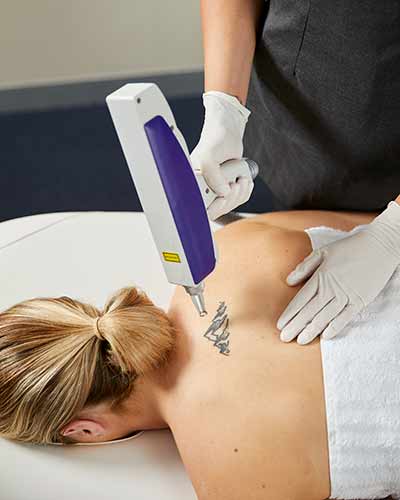 If you regret a tattoo, whether it was from your earlier years or a more recent acquisition, it no longer needs to be permanent.
If you regret a tattoo, whether it was from your earlier years or a more recent acquisition, it no longer needs to be permanent.
Our Q-Switched ND: YAG laser breaks down the ink particles in the tattoo. The broken down ink is then fought off by the immune system, mimicking the natural fading that time would create. The procedure is simple, safe and quick, producing great results.
It usually takes several treatment sessions to reach success with a minimum 6 week interval between sessions.
- Patch Test $15
- Very small (up to 2.5cm²) $50
- Small (up to 5cm²) $70
- Medium (up to 10cm²) $100
- Large (up to 15cm²) $130
- Extra large – price on request
LUX Series
Tattoo Removal
Getting Started with Tattoo Removal
When looking into tattoo removal it may be comforting to know that you aren’t alone. Statistics show that 1 in 3 Australians under 30 have a tattoo they regret. Thanks to advancements in aesthetic technology, more people than ever are seeking tattoo removal services to say goodbye to unwanted tattoos. LUX Series tattoo removal technologies offer you only highest quality, professional tattoo removal treatments to achieve your desired results while giving your skin the benefit of a fresh start.
Why get tattoo removal?
There are a number of reasons why people choose to get tattoos removed. These include wanting to erase an embarrassing spelling mistake or desiring to expand employment opportunities. Some simply opt for tattoo removal to make way for newer, more modern designs. Whatever the reason, LUX Series tattoo removal treatments work to turn back the clock on past mistakes so you can move forward with confidence – no more covering up!
How LUX Series Tattoo Removal works
LUX Series tattoo removal devices work by utilising a high powered Q-Switched Nd:YAG laser known for their outstanding ability to remove a variety of tattoo inks. The light is aimed at the unwanted tattoo and applied to the skin in pulses. This process allows the tattoo to absorb the light, which in turn shatters the pigments into tiny fragments. The fragments are then removed by the body’s natural filtration system. The result leads to permanent fading of the tattoo, or removal of the tattoo altogether.
It is also important to note that the wavelengths of light used during treatment are specifically designed to be attracted only to the tattoo pigments, leaving surrounding healthy skin tissue untouched.
Tattoo Removal FAQs
Am I suitable for LUX Series tattoo removal treatment?
LUX Series tattoo removal devices are advanced technologies suitable for treating most tattoo and skin types. During your consultation, your clinician will assess your unwanted tattoo and discuss with you the results you are likely to expect.
Does treatment remove all tattoo colours?
The results you can expect from your tattoo removal treatments will depend on the type of ink used in your tattoo, as well as the shade of ink. Darker colours generally respond better to tattoo removal treatment. Your clinician will assess your suitability for treatment, along with the results you can expect, during your consultation.
How many sessions will I need?
This all depends on the size, age, quality and colour of your unwanted tattoo. Some may need as little as six sessions to achieve a satisfying result, while others may require 12 or more to remove the tattoo completely.
How long do I need to wait between sessions?
Sessions are generally spaced at six week intervals, or more. This is because the tattoo removal process keeps working long after your session has finished. It takes time for your body to fully complete the natural process of clearing the treated tattoo inks, which is why after each session the skin is allowed time to heal and renew before moving on to the next stage of treatment.
Does it hurt?
The sensation felt during tattoo removal treatment will vary from person to person. Factors to consider include the pain threshold of the individual being treated, as well as the size, quality, colour and location of the tattoo (for example, removing a foot or neck tattoo will generally be more uncomfortable than a back tattoo).
Your clinician may engage various pain reduction methods such as topical anaesthetic, ise packs or a skin cooling system to help minimise the discomfort experienced when undergoing treatment.

 9 Florence Street, Taree 2430
9 Florence Street, Taree 2430 0492 930 538
0492 930 538